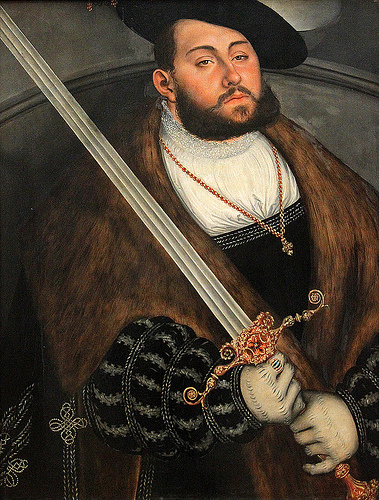John Frederick of Saxony
John Frederick of Saxony — (1503-1554) Leader of the Protestant Schmalkaldic League and known as the “Champion of the Reformation”. He was born into a noble family. He inherited the Electorate of Saxony (a state-like area of land near the German-Polish border today) in 1532 from his father. In his early days, John formed a close relationship with Luther after his esteemed teacher (who was a follower of Luther’s) introduced them. While in power, John encouraged the works of Luther to be published in many editions, and encouraged Luther’s teachings at the University of Wittenberg, over which he ruled. In his own castle, he built a chapel with a Lutheran design in mind and had Luther come preach the opening sermon. John’s own marriage took place in a Lutheran sermon. John Frederick continued to make a number of Lutheran-based reforms throughout his rule. As the Electorate of Saxony, John was the leader of the Protestant Schmalkaldic League and he used it to consolidate the Lutheran church. In 1537, a discussion about having a general council of both Protestants and Catholics was proposed and John had Luther write the Schmalkald Articles in preparation. This council was quickly rejected and John began to become more bold in his contempt for Catholicism, namely with the Emperor Charles V. In 1546, the Schmalkaldic War began between the Protestants and the Catholics.


John marched his troops south but when his cousin Duke Maurice invaded, he marched back north and pushed Maurice out again. Charles V decided to help Maurice and in the Battle of Mühlberg, in April, 1547, John’s forces were defeated. John received a slash to his face, which disfigured him, and was taken as the emperor’s prisoner. His wife continued trying to protect Wittenberg, along with his sons. John gave up his electoral and territorial rights in exchange for a lifelong prison sentence and the safety of his family. Throughout his prison sentence, he wrote letters to his sons and wife to stay true to Lutheranism and not to compromise their faith. He was offered freedom multiple times in exchange for his refuting of Protestantism, but he refused every time. In Sept. 1552, Duke Maurice went to war again, this time against Charles V, and John Frederick was freed. He was never granted his titles or land back but ended up in the city of Weimar trying to build up the University of Jena. He died there in 1554 with the respect of his Protestant peers and princes and the knowledge that he never turned his back on the faith to which he had dedicated his life.
See More: Charles V
Works Cited
https://en.wikipedia.org/wiki/John_Frederick_I,_Elector_of_Saxony
https://www.britannica.com/biography/John-Frederick-elector-of-Saxony
http://encyclopedia2.thefreedictionary.com/John+Frederick+I%2C+Elector+of+Saxony
Photo by f_snarfel 
